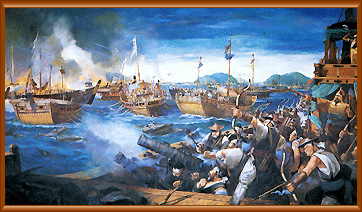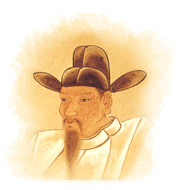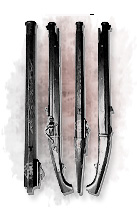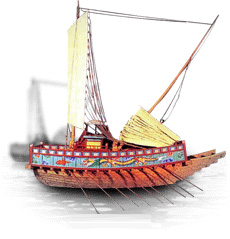The Battle of Hansando
It was the biggest and decisive naval battle during disastrous war, Imjin war which took place from 1592 to 1598. Battle-trained Japanese invaded under control of Toyotomi Hideyoshi. His ambition was broken in pieces by Joseon's Navy and Admiral Yi Sun-shin. After this battle, Japanese changed their strategy of their invasion of Korea and the whole war situation was dramatically reversed.
Historical Background
Toyotomi's ambition
At 1500s, Japan was in turmoil. The war between daimyos, feudal lords, kept dragging on and on until Toyotomi Hideyoshi united Japan.
 The battle in Hansan
The battle in Hansan
After unification, Toyotomi thought the chance to invade China had come to him. He always carried the fan which East Asia's map is printed on it. His ambition was to be the first Japanese ruler who conquered China. Furthermore, he worried about the possibility that his subordinate daimyos would rebel against him.
 Toyotomi Hideyoshi
Toyotomi Hideyoshi
Hanyang dispatched Tongsinsa, diplomatic mission, to Japan at 1590. They returned with Toyotomi's letter. In this letter, he claimed his war plan against Ming dynasty again. On the other hand, two envoys reported to their king after their trip. One of them asserted Toyotomi will invade within few years, but another opposed to this idea.
Joseon's preparation
To settle defense plans, Joseon government appointed new naval commanders of southern provinces' fleet. In February 1591, Yi sun-shin was appointed as Jeollajwado Sugunjeoldosa, commander-in-chief Jeolla province's western fleet and Yi eok-gi was appointed as Jellawudo Sugunjeoldosa, commander-in-chief Jeolla province's eastern fleet. In early 1592, Won gyun was appointed as commander-in-chief Gyeongsangdo province's eastern fleet. These commanders prepared for the war in their local seas. Jeollado province' commander, Yi sun-shin perfectly prepared to defend his domain sea. A lot of amount of armory, ammunition, gun powder, foods were reserved under control of him. New warships, including 3 Geobukseon were also built.
Japanese invasion
When King Seonjo was told the invasion of numerous Japanese army and Koreans' defeats, he dispatched his most trusted general, Sin Rip to defend Japanese invasion. General, Shin was famous for his missions against Manchus at the northern most border of Joseon dynasty. He defeated them in many times and became the General. Sin Rip confronted the first Japanese army, Gonishi yukinaga's at the Tanguemdae, Chungju, but his cavalry couldn't defeat Japanese. No one could halt the Japanese army's march to the Hanyang after this battle. On April 30, King seonjo retreated to Northwest, and Japanese seized
 Japanese matchlock gun
Japanese matchlock gun
The battle
Victory at sea
The situation at sea was obviously different. Combined Jeollado and Gyeongsangdo fleet defeated Japanese navy continuously. Before the battle of Hansando, combined Joseon fleet won for seven times. They could win because Joseon fleet was consists of well-trained navy and sailors and Joseon warships were well equipped with medium-and long- range guns. Furthermore, they had outstanding commander, Admiral Yi.
 Panokseon ship
Panokseon ship
Actually, Joseon navy was out of Toyotomi's strategy at first place. He ordered his daimyos to prepare many ships, mainly transport ships for the invasion of Korea. His invasion plan was focused on land battles and building castles. After continue defeats at sea, Toyotomi denounced his daimyos and ordered to change war strategy. Japanese troops of Wakisaka yasuharu, Guki yoshitaka and Gato yoshiyaki evacuated from north to the coast of the south sea. They built castles at Angolpo, Jinhae to ambush Joseon navy and prepared war battles. It became headquarter of Japanese navy.
Although, Toyotomi Hideyoshi ordered their navy to be united and attack Joseon navy together, Wakisaka Yasuharu decided to defeat Yi's fleet by himself. He was appointed as a chief of navy at the beginning of Imjin war, but couldn't have naval battle till this time. He thought he might gain more fame if he won. On July 7, 1592, his fleet was departed from the Japanese headquarter. When Wakisaka's fleet arrived near by Geojedo island, his fleet anchored off Gyeonnaeryang. On the other hand, Joseon's fleet was at Dangpo of Mirukdo island.
Fleet and commanders
| Winner : Joseon fleet | Japanese fleet | |
|---|---|---|
| Commanders | Joellajwado suguntongjesa : Yi sun-shin Joellajwudo suguntongjesa : Yi eok-gi Gyeongsangwudo suguntongjesa : Won gyun |
Commander-in-chief : Wakisaka Yasuharu |
| Warships | Korean record : 54 Japanese record : 109(Big ships: 59, Small ships: 50) |
Total : 73 |
At battle
On July 8, 5~6 ships went to Gyeonnaeryang while remaining ships were poised to attack off Hansando island. Joseon ships attacked ships which were anchoring off coast of Gyeonnaeryang. Immediately, Japanese boarded ships and counterattack to Joseon warships. Joseon warships poised to retreat from there, Japanese followed them.
When enticing ships arrived at the open sea, another Joseon fleet joined them. Admiral Yi commanded to make his famous tactic, Hakikjin, crane wing formation. Joseon ships formed like crescent moon and surrounded Japanese ships. This tactic's name derived from a shape of crane when it spread its wings. This tactic designed to attack enemy's Adake(flagship) or main squadron first and simultaneously. Joseon fleet discharged guns and 2~3 Japanese warships in front line were sunken by this attack. Joseon fleet attacked flagship first, it was main tactic of Admiral Yi. Soon, Japanese fleet was out of their commanders' order and dispersed to retreat, but Joseon fleet surrounded them and ambush their ships one by one. Most Japanese ships were sunken before they approached. This battle ended within 2~3 hours.
Result
Aftermath
Joseon enjoyed three advantages as a result of this battle. First, Joseon could keep their control in Jeollado and Chungcheongdo which were breadbasket of Joseon. The food supply was kept for Joseon army and fleet, it became huge advantage and base of Joseon's victory at Imjin war.
Second, Japanese attempts to defeat Joseon fleet were failed and they had to change war strategy of invasion. Their strategy was to deliver more Japanese land forces and foods through seas to northern part of Korean peninsula and then they would march to Ming dynasty's territory. By failure of this strategy, Japanese troops which seized north provinces of Joseon had to suffer from starving and shortage of ammunition. To invade China, they needed to secure war supplying routes. Japanese attempts to deliver foods and ammunition through roads were also blocked by Joseon army and Uibyeong. Uibyeong is literally translated as righteous army. A lot of civil army and Buddhist monk army voluntarily were formed and attacked Japanese troops.
Third, the army of Ming dynasty could march down to Korean peninsula by road, because Japanese troops couldn't march forward to the territory of Ming dynasty. King seonjo asked aid to the Ming dynasty and Ming sent their army to prevent invasion of Japanese troops in Korean peninsula.
After this battle, Admiral Yi's fleet secured south sea till the end of Imjin war and Joseon could protect their land from Japanese invasion. On August 18, 1595, Toyotomi Hideyoshi died, but his councilors kept his death as secret. After several months, this came to light and Japanese councilors ordered retreat of their troops in Joseon. On November 19, 1598, Yi's fleet attacked Japanese fleet was on their return to mother land, almost 200 Japanese warships were sunken and it became Yi's final battle. After few days, all Japanese troops withdrew from Busan and the disastrous Imjin war ended.
The result of this war impacted three countries in East Asia, Joseon, Ming dynasty and Azuchi-Momoyama period Japan. Joseon's lands were devastated by 7 years war and a lot of national treasures were destroyed or plundered by Japanese. Although, it took many years to rebuild country, Joseon dynasty lasted for about 300 years.
On the contrary of Joseon, Ming dynasty began to disintegrate and Toyotomi's government was replaced. Ming was suffered from economic decline and rebels against its government, and it was collapsed by Manchus in 1644. Manchu established China's last absolute monarchy state, Cheong.
Toyotomi's successor, Tokugawa Ieyasu moved capital to Edo, present-day Tokyo and Edo period started. Tokugawa proposed reestablishing diplomatic relations with Joseon in 1607. Two countries exchanged envoy till Meiji Restoration took place. Joseon dispatched diplomatic mission, which called as Tongsinsa. Tongsinsa was consists of about 500 people, including diplomats, painter, potter and doctors. Japanese could learn Joseon's technology by this diplomatic mission. Especially, Joseon's potters have had a strong influence on Japanese ceramic arts.
References
Show
- Immortal Yi Sun Shin(2004), KBS, Korea Broadcasting System
Books
- Jingbirok, Memory of disastrous war, Yu Seong-yong, Kim Hong sik(2003)
- Naval history of Imjinwar, Lee min-woong(2004)
- Nanjungilgi, War diary of Admiral Yi sun-shin , Roh Seung-seok(2005)
- 50 Military leaders who changed the world, William Weir(2007)
Websites
- Korean Naval academy : http://www.navy.ac.kr
- Korean Navy : http://www.navy.mil.kr
- Hyeonchungsa : http://hcs.cha.go.kr
- Geobukseon : http://www.gbs.go.kr